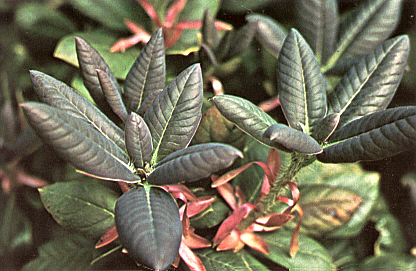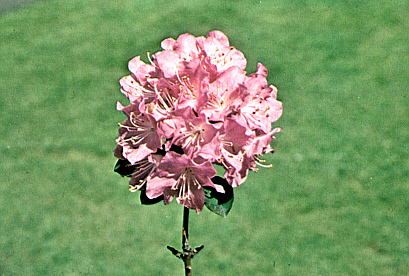British Gardens Revisited - Again
John D. Johnston, Asheville, N. C.
The third visit to British gardens proved to be the charm. Never was there such a sunny May as in 1971; never were the rhododendrons in such beautiful flower. Again we were in the congenial company of Frank and Helen Knight, and we set out from London right after the Rhododendron Show and returned in time for the Chelsea Flower Show.
We paid return visits to Exbury, Trengwainton, and Caerhays - all favorites. Peter Barber and Audrey Wyniatt were our guides through the cultivating grounds at Exbury, and pointed with especial pride to the beautiful R. 'Fortune Churchhill' A. M., which was blooming for the first time, and the great profusion of R. 'Naomi' in shaded pastels. Sir Simon Bolitho showed us the magnificent
R. falconeri
and R. 'Loderi' in full bloom at Trengwainton. At Caerhays, the hospitable Mr. and Mrs. Julian Williams received us most graciously, and we were pleased to see the gold Loder Cup in their possession. Outstanding here were the immense trees of
R. arboreum
x
griffithianum
and the largest known plant of the Chinese species
R. orbiculare
, covered with rose-pink bells, and its dark green round leaves glistening in the sun.
At last we saw Bodnant in full flower and it is a glorious sight. Mr. Puddle escorted us on a leisurely three hour tour of this best-kept of all the gardens. He keeps a staff of 30 men busy, and you can see the results everywhere. The
R. williamsianum
here is the most prolific of all; the R. 'Elizabeth' and
R. schlippenbachii
are considered the best in any garden. R. 'Crest' was in full golden bloom next to the bluest of all
R. augustinii
; R. 'Penjerrick' was a mass of white blossoms.
Over the Cumbrian Mountains to the coast is the 200-acre estate of Muncaster. It was planted by Sir John Ramsden, who is known as the father of Rhododendrons, and who advised on Kingdon-Ward's notebook. Here was the beautiful tree of R. 'Loderi King George,' very pink and in full bloom. The most spectacular sight was a whole hillside of rhododendrons falling down to the river Esk in a riot of color. It was hard to believe such beauty was actually real.
Mr. and Mrs. John Basford were again our hosts for the incomparable garden at Brodick, with its huge
R. falconeri
and its lovely tender plants of
R. lindleyi
, and R. 'Harry Tagg,' and its rare Chinese species of
R. glischrum
,
R. tsangpoense
, and
R. sidereum
. It was a veritable fairyland of bloom. Many of these we had seen only in glass houses.

|
|
FIG. 9. Frank Knight and Archie Gibson at Glenarn standing
under R. falconeri planted in 1848. Photo by J. D. Johnston |
We achieved an ambition of longstanding when we reached the top of the garden at Glenarn in Scotland and saw the delicate plants of pink-tinted
R. lindleyi
, which is quite rare. The Gibsons have made of their streams and hillsides overlooking the Firth of Clyde an ideal setting for rhododendrons featuring those grown from seeds brought back by George Sheriff, friend of the family. His
R. griffithianum
L & S 2835 was in full bloom, quite the loveliest we had ever seen, light pink and fragrant. Here also we saw a
R. falconeri
which was an unbelievable 35 feet high by 25 feet in diameter, with a trunk 12 inches in diameter. This tree was planted in 1848 from seed brought back by Sir Joseph Hooker. Figure 9 shows Frank Knight and Archie Gibson standing under this tree, which is lavishly covered with blooms. Mr. and Mrs. Gibson were gracious hosts, and we enjoyed their collection of pewter and samplers as well as their garden of lovely and unusual dwarf plants.
Now we are in the heart of western Scotland where the high rainfall and the mild climate produce magnificent rhododendrons. The greatest profusion of old rhododendrons planted over a hundred years ago from seed by Hooker is to be found at Stonefield Castle at the head of Loch Fyne. This is now a hotel for a limited number of guests, and little care is taken of the gardens. Frank Knight and I marveled at the size of these trees growing on the hillside, and appreciated anew the work of Hooker, who wrote back from China, "If your shins were as bruised as mine tearing thru the interminable Rhododendron scrub of 10,000-13,000 feet, you would be as sick of the sight of these glories as I am."
Crarae is in an open glen sheltered by woods and rising up from Loc Fyne. It is the 5,000 acre estate of Sir Islay Campbell, and its streams, rustic bridges, and hillside trails form the setting for this spectacular garden, assessed by Mr. Davidian as being the best of all in both situation and content.
Certainly one of the high spots of this successful tour was the Isle and garden of Gigha. The island, comprising 3,000 acres, is about 3 miles offshore Scotland and is reached by small boat from Tayinloan. Here we saw perhaps the most spectacular bloom of all -
R. nuttallii
x
lindleyi
- a cross made by Sir James Horlick, owner of the island and son of the founder of the malted milk empire. The plant was in full glorious bloom - great white trumpets with yellow centers. In this same walled garden were further feasts for the eyes -
R. lindleyi
, 'Tyermanii',
brachysiphon
,
iteophyllum
,
dalhousiae
, a perfect
yakushimanum
, and the only reported
R. preptum
in Scotland. Around any curve in the garden path there might open up an azalea garden in full bloom tucked away in the forest with Primulas and Cyclamen.
Lady Horlick was a most gracious hostess, and was proud of the progress of their island. She is kept busy putting in baths for 160 people on Gigha, and settling their quarrels. She has established a cooperative creamery where Gigha cheese is made and sent to market in London.
Peter Cox at Glendoick Gardens, near Perth, is doing much work in crossing and propagation, especially with the dwarf rhododendrons so well suited to small gardens. He was interested in some of our American crosses. He and his charming Irish wife have collected specimens in Nepal, and while waiting to go again, he keeps busy writing.

|
|
R. exasperatum
in new growth
at Royal Botanic Garden, Edinburgh Photo by J. D. Johnston |
One of the main attractions at the renowned Royal Botanic Gardens, Edinburgh, is Mr. H. H. Davidian, who showed us around. He is recognized in the United Kingdom as the final authority on the species. Here are 650 species in cultivation, and he says they are all his favorite. Here is true
R. wardii
from the seeds of several explorers, a rare Forrest
R. coryanum
,
R. smirnowii
from the Caucasus, and one of the four plants of
R. chlorops
in the United Kingdom (and each one different). It was a thrill to see the dwarf sweet-smelling
R. nivale
, which Hooker found at 19,000 feet in the Himalayas. Buried under snow for 8 months of the year, it is believed to be the rhododendron growing at the highest altitude in the world.
In a small walled garden behind a building we came upon a lovely plant with the curious name of
R. exasperatum
. This small rhododendron had finished blooming and had put out its new growth. The new leaves were as lovely as anything we saw. (See color page). Mr. Davidian said that Kingdon-Ward discovered the plant on a steep mountainside in southeast Tibet. He tried to reach it in very rough going, fell back, made another unsuccessful assault, and then finally reached it. He gave it then and there the name R. "exasperatum".
Mr. Davidian cut for us the lovely truss of
R. oreotrephes
which is deciduous under certain conditions.

|
|
R. oreotrephes
Royal Botanic Garden, Edinburgh
Photo by J. D. Johnston |
We were privileged to see the notebooks made by George Forrest in the field and which are stored in the laboratory of the Botanic Garden. Mr. Davidian showed us the pressed plants in the collection and explained that the blooms being dried up did not interfere with the identification of the rhododendrons. We also met a young botanist starting out for the far East and another expedition. It was a fitting end to our rhododendron tour.
Frank Knight says we have now seen most of the rhododendron gardens in Britain. Sad. We wish it were all to do over again. We were impressed throughout by the friendliness of the owners. The joys of knowing these wonderful people stand out in memory right along with the admiration of the glorious blooms. Each time we came we were even more delighted than the time before. We are happy we were able to repay the Knights at least in part this past summer when we introduced them to our lavish plant kingdom in the Great Smoky Mountains.